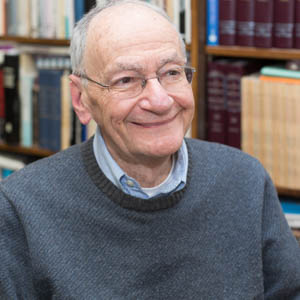Behind God’s Names

Judaism is a wellspring that emits an endless profusion of names for God. The Bible contains some 70; rabbinic literature adds another 90 or more and no one as yet has bothered to tally the number added by Jewish mystics. As Gershom Scholem wrote more than a half-century ago: “In the last resort, the whole of the Torah [for the author of the Zohar] is nothing but the one great and holy Name of God.” The layers of names bespeak an unbroken dialogue driven by love and mystery.
In this week’s parasha, we meet a common noun that would eventually become an extraordinary name for God. We read of Jacob’s flight from his brother’s wrath. Laden with anxiety, he leaves Beer-sheba to return to Haran, where Abraham had first received God’s summons. On the way, the Torah reports: “He came upon a certain place and stopped there for the night, for the sun had set (Genesis 28:11).” And, as you know, that place became the site for Jacob’s justly famous dream of a stairway filled with divine angels, some of which were ascending to heaven while others descended.
But precisely where was this awesome place which Jacob, upon awakening, would call “the abode of God” and “the gateway to heaven (Gen. 28:17)”? We ask for a degree of specificity to which the Torah is consistently indifferent. Rashi tries to help. He notes that grammatically the noun is accompanied by a definite article: ha-makom, literally “he came upon the place,” and goes on to suggest that it must be a place already mentioned by the Torah. Accordingly, he identifies it with the mountain upon which Abraham was ready to sacrifice Isaac, since the word makom appears in both verses (Gen. 22:4). Reflecting rabbinic tradition throughout, Rashi then asserts (in Gen. 28:17) that indeed this spot was the Temple Mount in Jerusalem which truly linked heaven and earth. In short, long after the destruction of the second Temple, the rabbis deepened the sanctity of Jerusalem and the Temple Mount by making them the locus of the two narratives in Genesis.
However, they did violence to the spirit of both stories, which are cast in the most general terms. In the case of Jacob, about to go into exile, the force of the unspecified place is to assure Jacob that God’s presence is not restricted to a single holy site or even the entire promised land. God would accompany and protect him beyond the borders back in Haran. The impulse to create a sacred piece of real estate ran counter to the message that God is universally accessible. Closer to the spirit of Genesis is the lesson taught by Rabban Gamliel not long after the Roman victory in 70 C.E.: “Why did God choose to reveal Himself to Moses in a lowly burning bush? To make the point that there is no place on earth which is devoid of God’s presence.”In time Rabban Gamliel’s view became concretized in a bold new name for God, perhaps my favorite, Hamakom, which we might render best as “the All-encompassing One.” The term expands beyond measure the indeterminate “place,” “makom,” of Genesis. God is now dauntingly conceived as the space in which the universe exists. God is neither outside the world nor a resident within it; the world constitutes a part of God. Transcending both gender and image, the conception expresses the grandeur and austerity of Jewish monotheism. It has the capacity to do justice to a universe more than 15 billion years old and still expanding.
No less important, it offers the comfort of God’s nearness. The ancient charge against Judaism was that its God was transcendent and remote and therefore inaccessible. Monotheism had emptied the world of all intermediate beings. Perhaps it satisfied the mind, but it chilled the heart. To counter this, the rabbis avowed that their God was both far and near, awesome and intimate. As the soul fills the body, God’s presence pervades the universe. God as Hamakom, the Spacious One, was meant to convey as well that one could pray in one’s heart without uttering a sound and still be heard by God. God was never out of reach. We were in fact immersed in God’s ubiquitous presence.
This paradoxical idea achieved ritual form in the prayer we extend to mourners in their moment of intense grief during the period of shiva. The divine name that we employ is Hamakom. “May the All- encompassing One comfort you among the mourners of Zion and Jerusalem.” The words stress that whatever the loss, the bereaved are not alone. Others in Israel have also been afflicted. And God shares their pain. No house of mourning, no place of suffering is without God’s presence. God softens the anguish of a community joined by fate and faith.
The challenge of Hamakom is to recognize God in the ordinary and every day. Our inclination to be awed only by the extraordinary dulls our senses to the miracles that surround us. The obligation to fill each day with no less than 100 berakhot, that is, exclamations of wonder and gratitude, creates a receptive state of mind to behold the divine in the common place. William Blake caught the spirit of Judaism perfectly when he wrote:
To see a World in a grain of sand, And a Heaven in a wild flower; Hold Infinity in the palm of your hand, And Eternity in an hour.
Behind the plethora of divine names that came to mark Judaism, there resonates but one defiant conviction: “that the Lord alone is God in heaven above and on earth below; there is no other (Deut. 4:39).” All that exists flows from a single source, even if no one name comes close to illuminating it, though Hamakom is a daring and lofty creation of the religious imagination.
Shabbat shalom u-mevorach,
Ismar Schorsch



